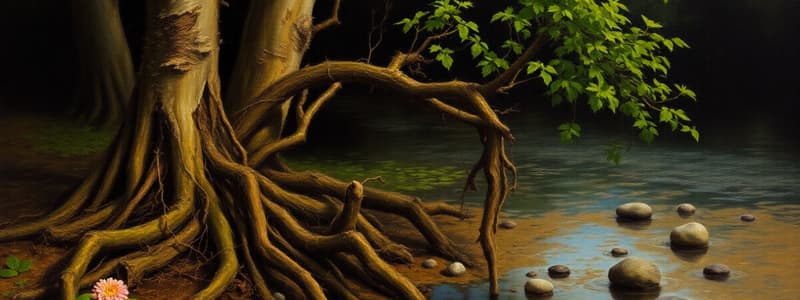Podcast
Questions and Answers
What is the primary role of decomposers in an ecosystem?
What is the primary role of decomposers in an ecosystem?
- To return elements from dead organisms back to the environment. (correct)
- To facilitate photosynthesis in plants.
- To provide energy for primary consumers.
- To convert atmospheric nitrogen into nitrates.
Which of the following conditions would most likely slow down the rate of decomposition?
Which of the following conditions would most likely slow down the rate of decomposition?
- A humid, warm environment lacking oxygen.
- A warm, moist environment with plenty of oxygen.
- A dark, moist environment with high oxygen levels.
- A cold, dry environment with limited oxygen. (correct)
Why is atmospheric nitrogen not directly usable by plants?
Why is atmospheric nitrogen not directly usable by plants?
- It is an inert gas that won't react with anything. (correct)
- Plants are unable to absorb gases in their roots.
- It needs to bond with other elements first.
- It is too reactive in its gaseous form.
What is the role of nitrifying bacteria in the nitrogen cycle?
What is the role of nitrifying bacteria in the nitrogen cycle?
How does lightning contribute to the nitrogen cycle?
How does lightning contribute to the nitrogen cycle?
Which process turns nitrates back into nitrogen gas ($N_2$)?
Which process turns nitrates back into nitrogen gas ($N_2$)?
How does storing food in a refrigerator help to preserve it?
How does storing food in a refrigerator help to preserve it?
What is the role of decomposers in the nitrogen cycle?
What is the role of decomposers in the nitrogen cycle?
What is the primary function of nitrogen-fixing bacteria in their symbiotic relationship with legume plants?
What is the primary function of nitrogen-fixing bacteria in their symbiotic relationship with legume plants?
Which process describes the conversion of water from a gaseous state to a liquid state in the water cycle?
Which process describes the conversion of water from a gaseous state to a liquid state in the water cycle?
What is the method of desalination that uses pressure to force water through a partially permeable membrane?
What is the method of desalination that uses pressure to force water through a partially permeable membrane?
What is the primary goal of reforestation efforts in relation to biodiversity?
What is the primary goal of reforestation efforts in relation to biodiversity?
Which of the following is NOT a benefit of maintaining biodiversity?
Which of the following is NOT a benefit of maintaining biodiversity?
What is the ONLY process by which carbon enters the carbon cycle from the atmosphere?
What is the ONLY process by which carbon enters the carbon cycle from the atmosphere?
What process releases carbon dioxide back into the atmosphere from decaying organic matter?
What process releases carbon dioxide back into the atmosphere from decaying organic matter?
What is the primary purpose of using a quadrat in the study of ecosystems?
What is the primary purpose of using a quadrat in the study of ecosystems?
Which of the following is a biological factor that can reduce food security?
Which of the following is a biological factor that can reduce food security?
What is the definition of sustainability?
What is the definition of sustainability?
Which of the following best describes an indicator species?
Which of the following best describes an indicator species?
Which indicator species is associated with clean water?
Which indicator species is associated with clean water?
What does the presence of sludge worms indicate about the quality of water in a river?
What does the presence of sludge worms indicate about the quality of water in a river?
What is a consequence of climate change on food security?
What is a consequence of climate change on food security?
What is the main cause of water evaporation in the water cycle?
What is the main cause of water evaporation in the water cycle?
What type of lichen indicates clean air?
What type of lichen indicates clean air?
What is the first level of organisation in an ecosystem?
What is the first level of organisation in an ecosystem?
What negative effect can excessive use of fertilizers have on aquatic ecosystems?
What negative effect can excessive use of fertilizers have on aquatic ecosystems?
How is efficiency calculated in energy transfer between trophic levels?
How is efficiency calculated in energy transfer between trophic levels?
What happens to plants during eutrophication when light is blocked by algae?
What happens to plants during eutrophication when light is blocked by algae?
Flashcards
Decomposition
Decomposition
The process where elements from dead organisms are returned to the environment.
Decomposers
Decomposers
Organisms, mainly bacteria and fungi, that break down dead organic matter.
Nitrogen Fixation
Nitrogen Fixation
The process by which nitrogen gas from the atmosphere is converted into usable forms like nitrates.
Nitrifying Bacteria
Nitrifying Bacteria
Signup and view all the flashcards
Denitrifying Bacteria
Denitrifying Bacteria
Signup and view all the flashcards
Rate of Decay
Rate of Decay
Signup and view all the flashcards
Factors Affecting Decomposition
Factors Affecting Decomposition
Signup and view all the flashcards
Urea
Urea
Signup and view all the flashcards
Individual
Individual
Signup and view all the flashcards
Population
Population
Signup and view all the flashcards
Eutrophication
Eutrophication
Signup and view all the flashcards
Energy Transfer Efficiency
Energy Transfer Efficiency
Signup and view all the flashcards
Trophic Level
Trophic Level
Signup and view all the flashcards
Symbiotic Relationship
Symbiotic Relationship
Signup and view all the flashcards
Water Cycle
Water Cycle
Signup and view all the flashcards
Desalination
Desalination
Signup and view all the flashcards
Thermal Desalination
Thermal Desalination
Signup and view all the flashcards
Osmosis
Osmosis
Signup and view all the flashcards
Reverse Osmosis
Reverse Osmosis
Signup and view all the flashcards
Biodiversity
Biodiversity
Signup and view all the flashcards
Reforestation
Reforestation
Signup and view all the flashcards
Conservation Schemes
Conservation Schemes
Signup and view all the flashcards
Carbon Cycle
Carbon Cycle
Signup and view all the flashcards
Photosynthesis
Photosynthesis
Signup and view all the flashcards
Respiration
Respiration
Signup and view all the flashcards
Quadrat Sampling
Quadrat Sampling
Signup and view all the flashcards
Food Security
Food Security
Signup and view all the flashcards
Indicator Species
Indicator Species
Signup and view all the flashcards
Study Notes
Decomposition
- Living things are composed of elements.
- Decomposition returns these elements to the air and soil after death or waste release.
- Bacteria and fungi are the primary decomposers.
- Decomposition rate depends on three factors:
- Temperature: Warmer temperatures accelerate enzyme-driven microbial reactions, increasing decay speed.
- Water content: Moist environments promote decay, as microbes need water to function.
- Oxygen availability: Abundant oxygen accelerates decay, as many microbes require it for aerobic respiration.
- Food preservation slows decomposition by reducing suitable conditions for microbial survival and reproduction.
- Refrigerating/freezing lowers temperatures to slow/stop microbial reproduction.
- Airtight containers prevent microbial entry and sterilization kills them.
- Drying food removes water, making survival impossible.
Nitrogen Cycle
- The atmosphere is ~78% nitrogen gas (N2).
- N2 is inert and unusable by plants and animals.
- Nitrogen must be converted to nitrates for plant use.
- Decomposers break down proteins in dead organisms and waste to return nitrogen to the soil.
- Nitrogen fixation converts atmospheric N2 into usable nitrogen compounds in the soil.
- Lightning provides the energy to convert N2 to nitrates.
- Decomposers break down organic matter releasing ammonia (NH3).
- Microorganisms (ammonia to nitrites, then to nitrates) convert ammonia to plant-usable forms.
- Nitrogen-fixing bacteria convert atmospheric N2 to ammonia.
- Denitrifying bacteria convert nitrates back to atmospheric N2.
- Some nitrogen-fixing bacteria reside in soil/roots of legume plants, forming a symbiotic relationship.
Water Cycle
- Solar energy evaporates water.
- Warm water vapor rises and cools.
- Condensation creates clouds.
- Precipitation (rain, snow, hail) provides fresh water.
- Water flows into bodies of water, repeating the cycle.
- Lack of precipitation causes drought.
- Desalination produces potable water by removing salts from seawater.
- Thermal desalination boils water, separating water vapor from salt.
- Reverse osmosis forces water through a membrane, separating it from salts under pressure.
Conservation and Biodiversity
- Biodiversity can be maintained and conserved through various methods.
- Human activity often reduces biodiversity, but some activities increase it.
- Reforestation in deforested areas increases biodiversity by providing habitats.
- Careful planning of reforestation efforts maximizes biodiversity by introducing diverse tree species.
- Species conservation schemes protect endangered species by:
- Protecting natural habitats.
- Establishing protected areas outside natural habitats (e.g., zoos).
- Captive breeding programs to increase populations.
- Seed banks for preservation of rare species.
- Maintaining biodiversity benefits humans by:
- Ensuring food security.
- Preventing damage to food chains.
- Providing future medicines.
- Supporting cultural aspects.
- Fostering ecotourism.
Carbon Cycle
- Carbon is a finite element within the Earth.
- Photosynthesis is the entry point for atmospheric carbon dioxide into the cycle.
- Plants convert carbon to carbohydrates, proteins, and fats.
- Animals consume plants and acquire carbon compounds.
- Respiration releases carbon dioxide (CO2) from both plants and animals.
- Decomposition releases CO2 from dead plants/animals by microorganisms.
- Burning of fossil fuels (wood, etc.) also releases CO2 back into the atmosphere.
Investigating Ecosystems
- Quadrat sampling measures the proportion of different components in a 1m2 area.
Food Security
- Increasing population and dietary shifts toward meat and fish negatively impact food security.
- There's less energy and biomass at higher trophic levels.
- Overfishing and environmental changes (climate change, soil pollution) pose risks to food security.
- Sustainability aims to meet current needs without impacting future generations.
Indicator Species
- Indicator species (sensitive to environmental changes) show human activity's impact.
- Water pollution can be indicated by oxygen-sensitive species (e.g., stonefly larvae, freshwater shrimp).
- Air pollution affects lichen types (e.g., clean air: green, fluffy lichens; polluted air: crusty lichens).
Ecosystems
- Ecosystems have different organizational levels:
- Individual: a single organism
- Population: all organisms of one species in a habitat
Human Impacts on Biodiversity and Eutrophication
- Human activities sometimes negatively impact biodiversity.
- Fertilizers leach into water bodies, causing eutrophication.
- Eutrophication: excess nitrates from fertilizers cause rapid algae growth, light blockage, plant death, and decomposition.
Food Chain, Tropic Layers, and Energy Transfers
- Energy transfer efficiency: = (energy transferred to next level / energy available at previous level) x 100
- Biomass transfer efficiency is calculated similarly.
- Trophic levels represent feeding positions in the food chain.
Studying That Suits You
Use AI to generate personalized quizzes and flashcards to suit your learning preferences.




